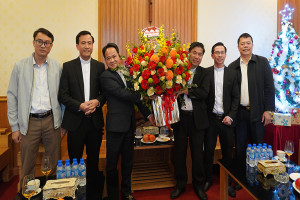
Several works of calligraphy by Vietnamese Zen master Thích Nhất Hạnh are now on display at the Vietnam University of Fine Arts on Hanoi's Yet Kieu Street.
The "Huong Thom Que Me" (The Fragrance of Motherland) exhibition, held April 14- 26, displays 100 works of calligraphy in various languages including Vietnamese, English, French and Chinese.
The works reflect the Zen master's love for Mother Earth, who nurtures and protects all sentient beings.
The exhibition takes its name from the title of a new book that features Thích Nhất Hạnh calligraphy.
According to Eve Yuen, a Hong Kong-based art critic, Hạnh's works are choreographic calligraphy that exude exquisite qualities, incorporating straight and solid lines as well as flowing curves in a balanced composition.
The works were earlier displayed in France, Germany, Canada, the U.S., Thailand, Taiwan, Hong Kong, and Ho Chi Minh City.
"Writing calligraphy is a practice of meditation," the Master has said.
"The way I do calligraphy, I do it in a certain way that can generate the energy of mindfulness, concentration, insight, and compassion during the time of practice."
Thích Nhất Hạnh, considered the second most influential Buddhist leader in the world after the Dalai Lama, studied and practiced Zen Buddhism from 1942.
Born in 1926, he became a monk at the age of 23 after studying Buddhism for seven years.
In the 1960s he spearheaded a movement by Buddhists in southern Vietnam that called for a negotiated end to the Vietnam War.
He left the country in 1966 and lived in Plum Village in southern France for decades, traveling regularly throughout North America and Europe to give lectures on mindfulness and peace.
Thích Nhất Hạnh is also a celebrated poet and peace activist. He was nominated for the Nobel Prize by Martin Luther King, Jr. in 1967, and is the author of more than 100 books, including several bestsellers like the "The Miracle of Mindfulness."




